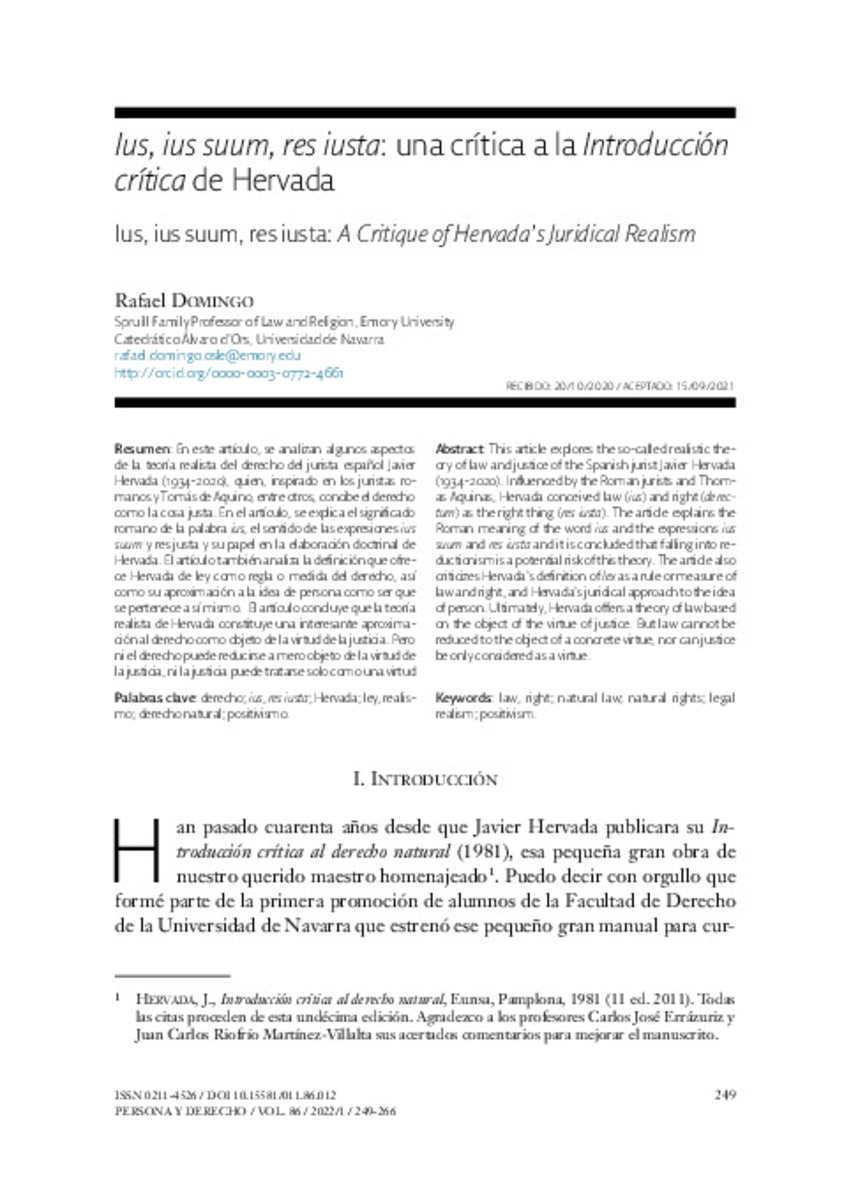Full metadata record
| DC Field | Value | Language |
|---|---|---|
| dc.creator | Domingo, R. (Rafael) | - |
| dc.date.accessioned | 2023-08-11T10:37:56Z | - |
| dc.date.available | 2023-08-11T10:37:56Z | - |
| dc.date.issued | 2022 | - |
| dc.identifier.citation | Domingo, R. (Rafael). "«Ius, ius suum, res iusta»: una crítica a la «Introducción crítica» de Hervada". Persona y Dereecho. (86), 2022, 249 - 266 | es |
| dc.identifier.issn | 0211-4526 | - |
| dc.identifier.uri | https://hdl.handle.net/10171/67113 | - |
| dc.description.abstract | En este artículo, se analizan algunos aspectos de la teoría realista del derecho del jurista español Javier Hervada (1934-2020), quien, inspirado en los juristas romanos y Tomás de Aquino, entre otros, concibe el derecho como la cosa justa. En el artículo, se explica el significado romano de la palabra ius, el sentido de las expresiones ius suum y res justa y su papel en la elaboración doctrinal de Hervada. El artículo también analiza la definición que ofrece Hervada de ley como regla o medida del derecho, así como su aproximación a la idea de persona como ser que se pertenece a sí mismo. El artículo concluye que la teoría realista de Hervada constituye una interesante aproximación al derecho como objeto de la virtud de la justicia. Pero ni el derecho puede reducirse a mero objeto de la virtud de la justicia, ni la justicia puede tratarse solo como una virtud. | es_ES |
| dc.description.abstract | This article explores the so-called realistic theory of law and justice of the Spanish jurist Javier Hervada (1934-2020). Influenced by the Roman jurists and Thomas Aquinas, Hervada conceived law (ius) and right (derectum) as the right thing (res iusta). The article explains the Roman meaning of the word ius and the expressions ius suum and res iusta and it is concluded that falling into reductionism is a potential risk of this theory. The article also criticizes Hervada’s definition of lex as a rule or measure of law and right, and Hervada’s juridical approach to the idea of person. Ultimately, Hervada offers a theory of law based on the object of the virtue of justice. But law cannot be reduced to the object of a concrete virtue, nor can justice be only considered as a virtue. | es_ES |
| dc.format.extent | 266 | es_ES |
| dc.language.iso | spa | es_ES |
| dc.publisher | Servicio de Publicaciones de la Universidad de Navarra | es_ES |
| dc.rights | info:eu-repo/semantics/openAccess | es_ES |
| dc.subject | derecho | es_ES |
| dc.subject | ius | es_ES |
| dc.subject | res iusta | es_ES |
| dc.subject | Hervada | es_ES |
| dc.subject | ley | es_ES |
| dc.subject | realismo | es_ES |
| dc.subject | derecho natural | es_ES |
| dc.subject | positivismo | es_ES |
| dc.subject | law | es_ES |
| dc.subject | right | es_ES |
| dc.subject | natural law | es_ES |
| dc.subject | natural rights | es_ES |
| dc.subject | legal realism | es_ES |
| dc.subject | positivism | es_ES |
| dc.title | «Ius, ius suum, res iusta»: una crítica a la «Introducción crítica» de Hervada | es_ES |
| dc.title.alternative | «Ius, ius suum, res iusta»: A Critique of Hervada’s Juridical Realism | es_ES |
| dc.type | info:eu-repo/semantics/article | es_ES |
| dc.publisher.place | Pamplona | es_ES |
| dc.identifier.doi | doi.org/10.15581/011.86.012 | - |
| dadun.citation.endingPage | 266 | es_ES |
| dadun.citation.number | 86 | es_ES |
| dadun.citation.publicationName | Persona y Dereecho | es_ES |
| dadun.citation.startingPage | 249 | es_ES |
Files in This Item:
Statistics and impact
Items in Dadun are protected by copyright, with all rights reserved, unless otherwise indicated.






